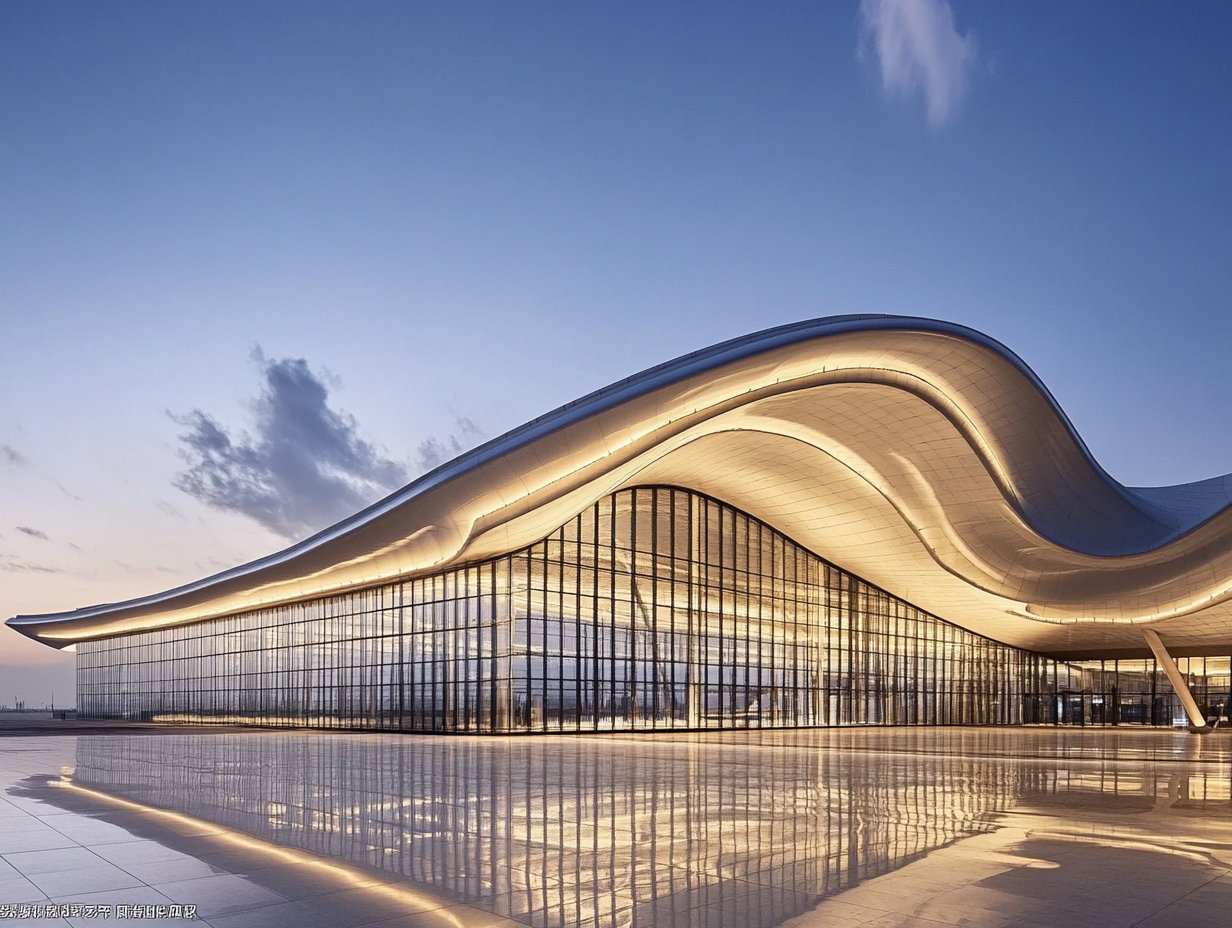Finding beauty in the airport may sound more like a philosophical experiment than a realistic travel experience, but the most innovative terminals of today are prioritizing architecture and aesthetics as integral elements of their design.
Every year, the Prix Versailles architecture awards highlights the most beautiful new airport terminals around the world. Beyond just visual appearances, the prize also aims to recognize intelligent sustainability in airport design.
Modern airports “must resolve formidable difficulties in terms of flow management and the aircraft themselves,” Jérôme Gouadain, secretary general of the Prix Versailles, said in a statement. “This new brand of facilities can also be seen as works of art, or at least as things of beauty.”
The six airports that made the 2025 Prix Versailles list harness design elements that evoke the serenity of nature while incorporating innovations to limit carbon output. In December, three of the airports will be selected to win the even more prestigious Prix Versailles World Title.
Below are the six most architecturally stunning new airports of 2025.
China’s Yantai Penglai International Airport Terminal 2
Yantai’s seaside landscapes were the inspiration for the new terminal at the city’s international airport. The building’s large undulating roof was inspired by nearby Kunyu Mountain, and its interior curves and stone were designed to mimic the region’s scenic coastline.
Skylights are interspersed throughout the structure, designed to guide passengers to the departure gates. At the terminal’s apex, a glazed diagrid dome sits above a multi-story atrium, allowing natural light to filter down through the building. Abstract interpretations of wooden ships’ hulls are scattered throughout, a nod to the region’s Maritime Silk Road history. In order to minimize impact on the surrounding land, the building itself is laid out in an E-shape, which also helps to optimize passenger flow.
The 167,000-square-meter terminal building was designed by Aedas along with CSWADI and the Shanghai New Era Airport Design and Research Institute. Opened in June 2024, the new building has increased Yantai airport’s total capacity of 23 million passengers per year.
Get there: Although the airport is mainly utilized for international flights between China, Korea, and Japan, US travellers can find one-stop routes to Yantai from 11 major US airports with Korean Air.
France’s Marseille Provence Airport Terminal 1
Travellers arriving into Marseille, France (one of Condé Nast Traveller’s best places to go in 2025) will find the glamour of Provence now begins at the airport. A new building links the airport’s two existing Terminal 1 structures, which were constructed in the 1960s and 1990s. The link, which is called a coeur, or heart in English, is a window-lined hall with soaring, 72-foot ceilings featuring a grid of polished aluminum skylights to promote natural ventilation. The building itself is made of 70% recycled steel and adds 28,000 square metres of space to the airport.
A warm French timber canopy encloses the security area, while the terminal’s wood-clad shops and restaurants are a visual homage to the boat houses found in the Old Port of Marseille. Floor-to-ceiling windows grant sweeping views of Provence’s hills and Marseille’s lagoon for an added sense of calm. Foster + Partners, which designed the new building, had an overall goal of “reorganizing passenger flows through a set of simple, bright, and easy to navigate spaces.”
Get there: US fliers can travel to the airport on a one-stop itinerary with Air France from New York, Los Angeles, Atlanta, Miami, San Francisco, Tampa, Austin, Boston, Cincinnati, Dallas, Raleigh, Washington DC, Denver, and Detroit.
Réunion Island’s Roland Garros Airport Arrivals Terminal
A paradise in the Indian Ocean, Réunion Island’s newest airport terminal harnesses the isle’s tropical nature and frequent trade winds to reduce its carbon footprint. Drawing inspiration from the island’s famous green canyons, the bioclimatic airport structure houses a central “canyon” that acts as a thermal chimney to enable natural ventilation. On the building’s exterior, 830 sets of louvered shutters are connected to a series of sensors on the facade. The shutters’ angles are adjusted in real time to respond to the island’s frequently changing weather conditions. This also creates a low-pressure system that extracts the interior air, according to AIA Life Designers, the architecture firm behind the project.
Inside the arrivals hall, travellers will get a taste of the island’s natural wonders as soon as they step off the plane, thanks to the extensive use of wood throughout the building, as well as lush native vegetation throughout.
Get there: Réunion Island is an official department of France, and US passengers can fly to Réunion on one-stop itineraries with Air France from 14 American gateway cities.
Japan’s Kansai International Airport Terminal 1
Adding a new building to Osaka’s Kansai Airport was no simple feat. Built by renowned architect Renzo Piano on an artificial island, the existing facility is known as a paragon of innovation and high taste. But the airport’s new Terminal 1 building managed to live up to that illustrious legacy.
The new interior spaces were designed with a palette of natural materials to give the space “a distinctly Japanese feel,” according to architecture firm Populous. The international departure lounge and retail area is now 60% larger with a commercial section that includes 13 stores and a street food court that features Japanese staples like ramen, udon, and plenty of sushi shops, as well as upscale chains like a Dior café. It’s hard to imagine better airport food than that!
Another addition is a new security area that has faster smart lanes, which can process up to 6,000 passengers per hour. “The new queuing management system is the first of its kind in Japan, automatically controlling flapper gates to switch waiting lines by utilizing real-time passenger flow data,” says Populous. “The system enables passengers to be automatically guided to the security inspection lanes based on the number of passengers and their flow.”
The project has increased the terminal’s annual passenger capacity by a significant 25%, and it opened just in time to accommodate millions of travellers visiting Osaka for the 2025 World Expo.
Get there: For American travellers looking to visit Osaka, United Airlines operates nonstop flights to Kansai International Airport from San Francisco, Japan Airlines flies a nonstop route from Los Angeles, and Hawaiian Airlines has nonstop flights from Honolulu.
Portland International Airport Main Terminal
Portland’s new terminal brings the beauty of the Pacific Northwest indoors by emulating Oregon’s lush forests. In fact, architecture firm ZGF said the terminal’s design concept was inspired by walks in the forest, with the goal of creating a similarly immersive and calming experience for passengers. The most distinctive feature is the building’s wave-like roof made of nine acres of local Oregon timber, sourced from landowners and mills within 300 miles of the airport, including community forests practicing sustainable forestry.
The terminal follows the concept of biophilia, or the tendency for humans to seek out nature. Main walkways throughout the terminal are filled with sunlight and greenery: There are 72 large trees inside the building that stretch up to 25 feet tall, as well as 5,000 other green plants sprouting throughout the space. The timber roof slats diffuse light in a similar manner as a forest canopy, and 60% of the terminal is bathed by natural light.
In the concessions hall, local purveyors like Blue Star Donuts + Coffee, Mo’s Seafood & Chowder, and Powell’s Books contribute to the strong sense of place. There’s even a microcinema showcasing short films by local filmmakers. The new terminal is designed to double the airport’s capacity and accommodate 35 million passengers a year by 2045.
Get there: Portland International Airport (PDX) is a hub for Alaska Airlines, and a focus city for other major US carriers like Delta, American, and United.
San Francisco International Airport Terminal 1
SFO’s newest building sports some impressive statistics, but they have nothing to do with passenger numbers. Rather, it’s the respectable size of the facility’s carbon footprint that is awe-inspiring. The recent in-depth renovation has shrunk the building’s carbon output by 79% and reduced its overall energy usage by 59%. Other impressive numbers include a waste diversion rate of over 90% and a 50% reduction in potable water use.
Efficient design elements such as fritted glass for glare reduction, photovoltaic panels fitted to the roof, and a low-carbon baggage handling system all added up to create major results. The architectural teams at Gensler and Kuth Ranieri even installed two plumbing systems to separate non-potable water to be used in flushing fixtures and for landscaping.
But amid all of these reductions, passengers don’t have to sacrifice any aspect of comfort. The terminal has spacious skylights throughout for doses of sunlight as well as creative design touches to highlight San Francisco’s unique arts and crafts style. The building is also home to the SFO museum, which is the world’s only accredited museum inside an airport.
Get there: Alaska Airlines is the largest domestic carrier operating out of SFO’s Harvey Milk Terminal 1. American Airlines, JetBlue, and Southwest Airlines also offer flights.



